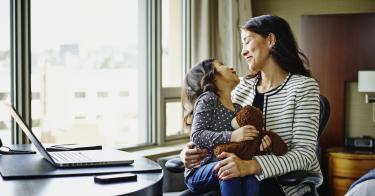The media have been quick to run with “Shecession” stories claiming that the pandemic undid decades of progress for women in the workforce. Perhaps they should slow down. Turns out the COVID-19 pandemic just could precipitate a giant leap forward for women’s work.
It’s true that, early on in the pandemic, women lost more jobs than men. They were also more likely to drop out of the labor force to stay home with children when schools and day care centers closed.
But women have largely recovered from those initial disparities, and the workplace changes brought on by the pandemic will arguably propel women forward as opposed to setting them back.
Consider these then-and-now numbers. In the first two months of the COVID-19 pandemic, women’s employment was down by 1.2 million more than men’s. But as of April 2021, men’s employment is actually down by 144,000 more than women’s. Female unemployment peaked at 16.1% in April 2020 as men’s hit 13.6%. Yet today, the unemployment rate among women is lower than among men (5.8% vs. 6.3%).
>>>How Has COVID-19 Affected Women in the Workplace?
And while women’s labor force participation rate has declined slightly more than men’s (1.7 percentage points vs. 1.6) since the pandemic began, women’s 5.3% increase in earnings is more than twice that of men’s 2.2% gain.
So perhaps it’s not all gloom and doom for working women.
Striking the right balance between work and family (and other personal and professional pursuits) has never been easy. No one formula works across all ages and stages of life, nor across everyone’s unique circumstances and ideals.
But it’s more likely that the COVID-19 pandemic will propel women forward than set them back.
The pandemic has broken down barriers to more flexible and family-friendly work environments, making it easier for current and future generations of women—myself and my daughters included—to achieve the work and family pursuits that we desire.
For mothers with young children—myself included—flexibility is extremely important.
Even before the pandemic, employers were adding flexible work policies as a way to attract and retain workers in a tight labor market. And web- and app-based platforms provided opportunities for more people to earn income outside the confines of a traditional 9-to-5 job.
COVID-19 brought this to a whole new level—one that likely would have otherwise taken a decade or more to achieve.
Companies were forced to implement remote-work technology and adopt more flexible workplace schedules just to survive. Many companies now realize they can thrive through such changes.
COVID-19’s impact on workplaces also helped break down some of the barriers—even stigmas—that separated work and family life. The BBC video that went viral in 2017, when a child walked in during her father’s television interview, is now commonplace.
>>> The Gender Pay Gap: Choice, Children, and Public Policy
The leap forward in technology and added awareness of individuals’ personal and family circumstances will almost certainly bring permanent changes that will particularly benefit women.
Just as women’s workplace recovery relative to men resulted from governments easing restrictions on businesses and allowing schools to fully reopen, women’s future prospects also depend on government policies not standing in their way.
President Biden and many members of Congress are using the bygone disparities of COVID-19 on women as an excuse to enact a slate of government programs that will give politicians more control over women’s and families’ lives.
Not only have programs such as government-run paid family leave and subsidized government child-care programs proved ineffective at improving women’s success in the workplace, they’ve resulted in a host of unintended consequences detrimental to women, children and families.
Now that societal reopenings have mostly reversed the shutdown’s disparate impacts on working women, it is time to embrace the positive changes in workplace flexibility and family-friendly policies that have and hopefully will continue to ensue. Instead of proposing new interventions, policymakers should look to removing existing government barriers so that more women can pursue the career and family choices that are best for them.
This piece originally appeared in The Washington Times




